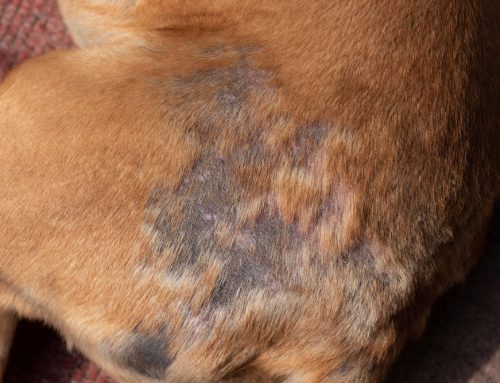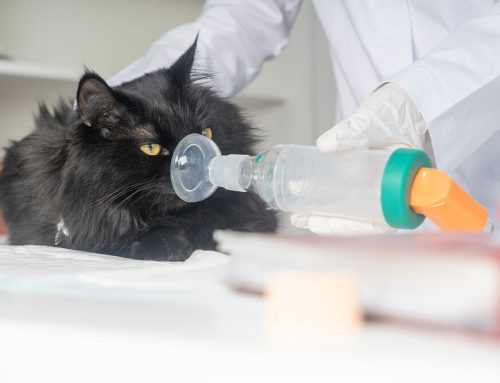Pet obesity has become so normalized that many pet owners don’t realize their furry pal is overweight. Our Valley Center Veterinary Clinic team wants you to understand the reasons behind your pet’s health needs, so you can take the appropriate steps to provide the care they need. Since pet obesity is one of the most common health issues we recognize in our patients, we explain why this condition is so concerning and recommend tips that will help keep your pet at a healthy weight.
Pet obesity prevalence
According to the Association for Pet Obesity Prevention’s (APOP) 2022 report, 59% of dogs and 61% of cats were classified as overweight or obese by their veterinary care provider. In addition, the report showed that 36% of dog owners and 28% of cat owners considered their pet’s weight normal, although they were actually overweight or obese. Specific definitions include:
- Overweight — Pets are considered overweight when they are 10% to 20% over their ideal body weight.
- Obese — Pets are considered obese when they are more than 20% over their ideal weight.
Pet obesity dangers
Many pet owners shower their four-legged friend with treats to show their love, but this practice contributes to weight gain and increases your pet’s risk for several serious health issues, including:
- Diabetes — Overweight cats are three times more likely to develop diabetes than healthy weight cats, and dogs are also at increased risk.
- Hypertension — Many overweight pets develop high blood pressure, which puts them at risk for heart and vascular issues, kidney disease, and retinal detachment.
- Mobility issues — Pets with excess weight are much more likely to develop arthritis, and the excess weight can also physically inhibit their mobility.
- Urinary tract disease — Overweight cats are at higher risk for urinary tract issues, such as urinary stones, urinary tract infections, and feline idiopathic cystitis.
- Respiratory issues — Overweight pets have fat lining their chest and abdominal cavities that can hinder their breathing.
- Cancer — Studies have demonstrated that obesity is linked to several human cancers, and evidence is increasing that the same is true for dogs and cats.
- Skin disease — Skin folds created by excess fat are ideal bacteria and yeast breeding grounds that can lead to chronic and recurrent skin infections.
Being overweight negatively impacts your four-legged friend’s quality of life, and may shorten their life by about two years compared with healthy weight cats and dogs.
Pet obesity diagnosis
While you can find healthy weight range charts for pets, their weight is not the best determinant of their weight status. Your pet’s body condition score (BCS), which is a quantitative assessment of fat accumulation rating a pet on a scale from one (i.e., emaciated) to nine (i.e., obese), is a much better weight status indicator. A BCS assessment is performed by:
- Feeling your pet’s body — Palpate your pet’s ribs and spine. They should have a thin fat layer that allows you to easily feel, but not see, the bones.
- Observing your pet from above — When you look at your pet from above, you should see a noticeable waist that indents behind their ribs. If they have no indentation or a bulging waist, they likely are overweight.
- Observing your pet from the side — When you look at your pet from the side, you should see a discernible abdominal tuck. If they have no abdominal tuck or their tummy sags toward the ground, they likely are overweight.
Pet obesity treatment
If your pet is overweight, schedule an appointment with our Valley Center Veterinary Clinic team, so we can devise a safe weight loss strategy. Do not suddenly cut back your pet’s calories, which can lead to serious health issues such as malnutrition and hepatic lipidosis—always consult a veterinary professional before putting your pet on a diet. Prescription veterinary diets will help ensure your pet receives adequate nutrition and remains satiated while losing weight.
Pet weight management tips

To keep your pet at a healthy weight, follow these tips:
- Schedule regular pet wellness exams — Annual or bi-annual pet wellness exams help our team detect conditions, such as hyperadrenocorticism and hypothyroidism, that can influence your furry pal’s weight.
- Calculate your pet’s daily calorie requirements — Determine your pet’s daily caloric needs with a pet calorie calculator, which considers your pet’s breed, age, weight, BCS, activity level, and spay or neuter status.
- Accurately measure your pet’s meal portion — Read your pet’s food label to determine how much food constitutes their required calories and then measure their meal portion accurately with a measuring cup or kitchen scale to ensure they receive the right amount.
- Limit your pet’s treats — Your pet’s treats should account for no more than 10% of their daily calorie intake, and should include healthy options, such as baby carrots, snap peas, and blueberries.
- Exercise your pet — Pets must exercise daily to keep them fit and trim—generally, dogs need at least 30 minutes of daily physical activity, and cats need three five-minute intense play periods throughout the day. However, these are general recommendations, and you should ask our team about your pet’s specific physical activity needs.
- Prevent scavenging — Keep your garbage in sealed containers and food off your counters to prevent dumpster diving and counter surfing.
- Ensuring all family members are on board — If your pet eats table scraps that your spouse sneaks them, or eats your child’s unattended snack, they more likely will gain weight. Ensure everyone in your family understands the importance of keeping your pet at a healthy weight and is on board with the plan.
To schedule a wellness exam or have your pet’s BCS properly assessed, contact our American Animal Hospital Association (AAHA)-accredited team at Valley Center Veterinary Clinic.







Leave A Comment